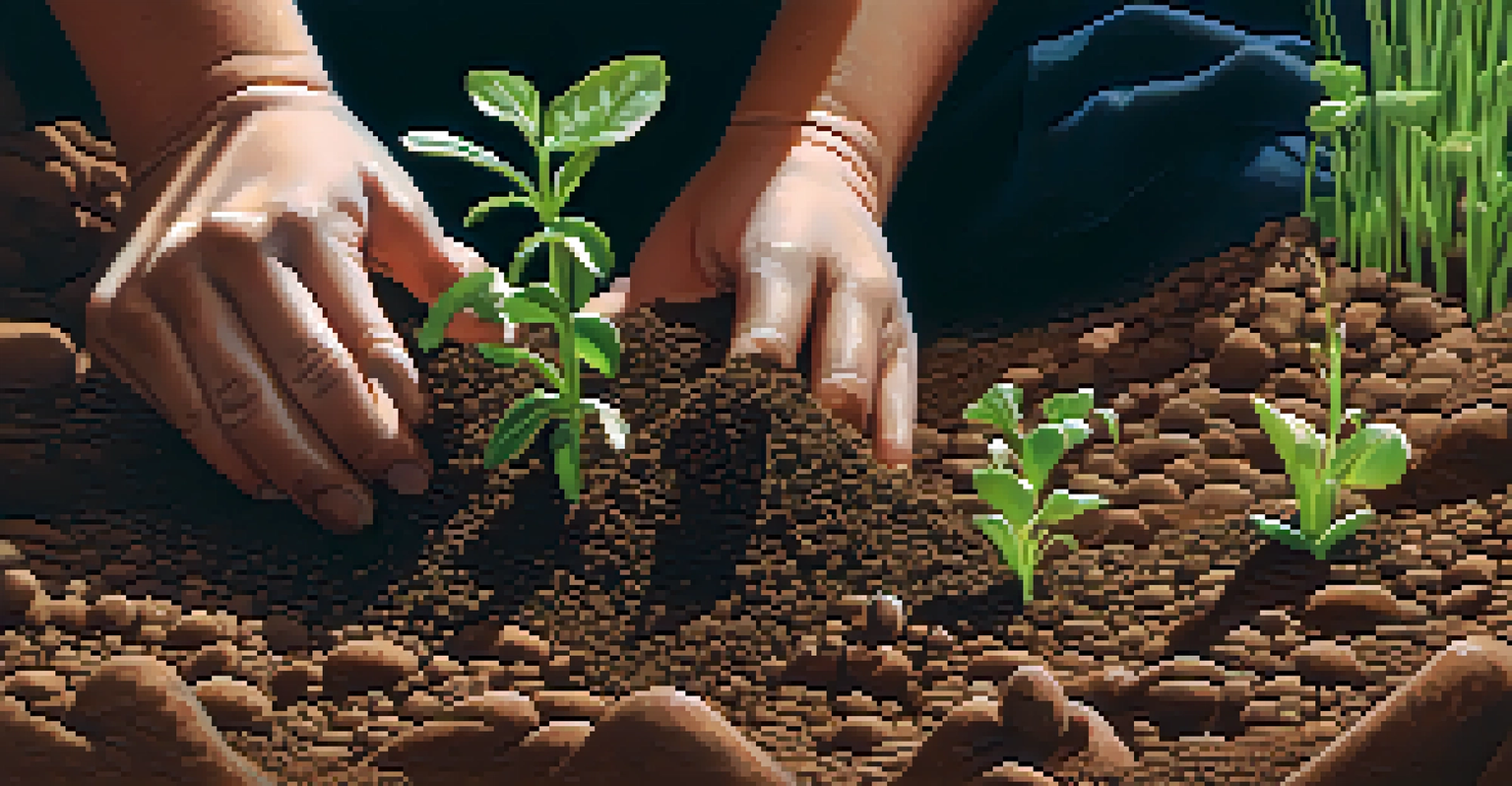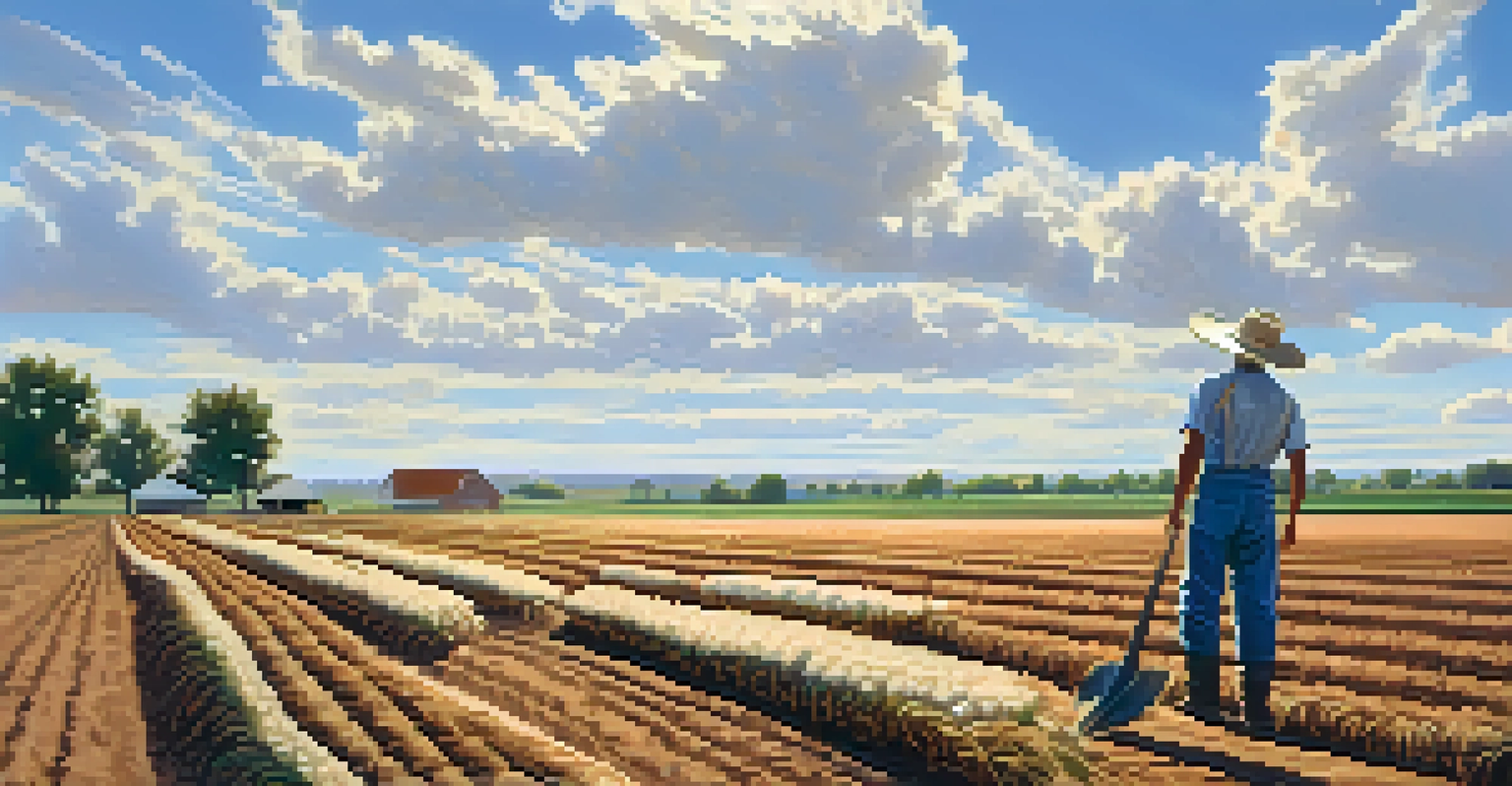Missouri's Soil Types: Key to Successful Agriculture

Introduction to Missouri's Unique Soil Types
Missouri's agricultural landscape is deeply influenced by its soil types, which vary widely across the state. Understanding these differences is key for farmers aiming to optimize their crop yields. From the fertile alluvial plains to the rocky hillsides, each soil type presents unique opportunities and challenges.
The soil is the great connector of our lives, the source and destination of all.
The state's geography, shaped by rivers and glacial deposits, has created a mosaic of soils. This diversity is essential for various farming practices, impacting everything from crop selection to irrigation methods. By recognizing the characteristics of each soil type, farmers can better tailor their approaches to enhance productivity.
Ultimately, a solid grasp of Missouri's soil types not only helps in making informed agricultural decisions but also contributes to sustainable farming practices. As we dive deeper into the specific soil types, you'll see how they play a crucial role in the state's agricultural success.
The Role of Alluvial Soils in Agriculture
Alluvial soils, formed by sediment deposited by rivers, are among the most fertile in Missouri. They are typically found in the floodplains of major rivers like the Missouri and Mississippi. Farmers often favor these soils for growing crops like corn and soybeans due to their nutrient-rich composition.

The high organic matter content in alluvial soils enhances moisture retention, which is vital for crop growth. This characteristic makes them particularly advantageous during dry spells, helping to ensure that crops receive the water they need. Furthermore, their fine texture allows for easy tilling, making planting and harvesting more efficient.
Diverse Soils Enhance Crop Productivity
Understanding Missouri's varied soil types allows farmers to optimize their crop selection and farming practices.
However, managing alluvial soils requires attention to erosion and flooding risks. Farmers need to implement practices such as crop rotation and cover cropping to maintain soil health and prevent degradation. By embracing these strategies, they can maximize the benefits of alluvial soils while minimizing their vulnerabilities.
Understanding Clay Soils and Their Challenges
Clay soils are prevalent in many parts of Missouri, characterized by their dense and sticky texture. While they can retain moisture exceptionally well, this can also lead to drainage issues, especially during heavy rainfall. Farmers working with clay soils must navigate these challenges to ensure healthy crop development.
Healthy soil is the foundation for healthy food, healthy animals, and healthy people.
The compact nature of clay can hinder root growth and make it difficult for plants to access nutrients. To counteract this, farmers often mix organic matter into the soil, improving its structure and promoting better drainage. This practice not only boosts fertility but also enhances aeration, allowing roots to thrive.
Despite these challenges, clay soils can be quite productive with the right management techniques. Utilizing practices such as no-till farming and strategic crop selection can help farmers optimize their yields while preserving soil health. This balance is essential in creating sustainable agricultural systems in clay-dominated areas.
Sandy Soils: The Double-Edged Sword
Sandy soils, while less common, are found in certain regions of Missouri and come with their own set of advantages and disadvantages. These soils are known for their excellent drainage and warm-up quickly in the spring, making them ideal for early planting. However, they also have lower nutrient-holding capacity, which can pose challenges for farmers.
The quick drainage of sandy soils means they can dry out rapidly, especially during hot summer months. To mitigate this, farmers often need to incorporate organic matter and employ efficient irrigation practices to maintain adequate moisture levels. Crop selection is also crucial, with drought-resistant varieties often being favored.
Soil Conservation is Essential
Implementing soil conservation practices helps maintain soil health and ensures sustainable agricultural productivity.
Despite these challenges, sandy soils can yield excellent results with the right management. By understanding their unique properties and implementing targeted strategies, farmers can take advantage of the benefits while addressing the potential downsides. This adaptability is key to thriving in sandy soil regions.
The Importance of Loam Soils in Crop Production
Loam soils are often considered the 'gold standard' for farming due to their balanced mixture of sand, silt, and clay. This combination results in excellent drainage, moisture retention, and nutrient-holding capacity, making loam ideal for a wide range of crops. Many Missouri farmers seek out these soils for their versatility in crop selection.
The balanced texture of loam allows for easy tilling, promoting healthy root growth and overall plant vigor. Additionally, loam soils are less prone to erosion compared to sandier or clay-heavy soils, making them a stable option for sustainable agriculture. This stability is crucial in maintaining long-term productivity.
Farmers working with loam soils often report higher yields and better crop quality. By understanding and leveraging the advantages of loam, they can implement effective crop rotation and cover cropping strategies, ensuring that their soil remains fertile for generations to come. This commitment to soil health is foundational for successful agriculture.
Soil Conservation Practices for Missouri Farmers
Soil conservation is vital for maintaining the health and productivity of Missouri's diverse soils. Practices like contour farming, terracing, and cover cropping help prevent erosion and improve soil structure. By adopting these methods, farmers can protect their land from degradation and enhance its long-term viability.
In addition to traditional methods, precision agriculture is becoming increasingly popular among Missouri farmers. This approach utilizes technology to monitor soil health and optimize farming practices, allowing for more efficient use of resources. By tailoring their strategies to specific soil conditions, farmers can maximize yields while minimizing environmental impact.
Adaptation to Climate Change Needed
As climate change impacts agriculture, farmers must adapt their practices to maintain productivity amidst unpredictable weather.
Ultimately, investing in soil conservation not only benefits farmers but also contributes to the broader ecosystem. Healthy soils help sustain water quality and support biodiversity, creating a more resilient agricultural landscape. As farmers embrace these practices, they play a crucial role in ensuring the sustainability of Missouri's natural resources.
The Future of Agriculture in Missouri's Changing Climate
Climate change poses significant challenges for agriculture in Missouri, impacting everything from rainfall patterns to temperature extremes. As weather becomes less predictable, understanding soil types and their responses to these changes becomes increasingly important. Farmers must adapt their practices to ensure continued productivity in the face of these challenges.
By leveraging the unique characteristics of Missouri's various soil types, farmers can implement strategies that enhance resilience. This might include diversifying crops, adopting conservation tillage, or investing in soil health initiatives. Each of these practices can help mitigate the impacts of climate change on agricultural production.

Looking ahead, collaboration among farmers, researchers, and policymakers will be essential in developing innovative solutions. By working together, they can create a more sustainable agricultural system that not only withstands climate challenges but thrives in them. The future of Missouri agriculture relies on this collective effort to protect and enhance its invaluable soils.
Conclusion: Embracing Soil Diversity for Agricultural Success
Missouri's diverse soil types are a significant asset for its agricultural community. By understanding the characteristics and challenges of each soil type, farmers can make informed decisions that lead to successful crop production. This knowledge empowers them to embrace sustainable practices that preserve the land for future generations.
The journey through Missouri's soils reveals the intricate connections between soil health and agricultural productivity. Whether working with alluvial, clay, sandy, or loam soils, farmers have the opportunity to maximize yields while fostering environmental stewardship. Each soil type offers unique benefits that can be harnessed with the right management techniques.
In conclusion, embracing the diversity of Missouri's soils is key to ensuring a prosperous agricultural future. As farmers continue to adapt and innovate, they will not only enhance their own operations but also contribute to the resilience of Missouri's agricultural landscape as a whole.